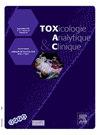High-resolution mass spectrometry screening in forensic toxicology
IF 1.7
Q4 TOXICOLOGY
引用次数: 0
Abstract
Objective
This presentation aims to introduce high-resolution mass spectrometry (HRMS) screening techniques to new users with forensic toxicology applications.
Introduction
HRMS is becoming an increasingly used technique in forensic toxicology. This technique offers essential advantages compared to classic screening techniques in toxicology, such as immunoassays and gas chromatography-mass spectrometry. HRMS has increased specificity, sensitivity, and versatility. It can be employed in targeted screening, suspect screening, tentative identification, structure elucidation, and quantitative and confirmation methods.
Methods
This presentation will explore all the steps involved in developing, employing, and validating HRMS screening techniques, including sample preparation procedures, chromatographic separation, HRMS instrumentation and data acquisition modes, data analysis and interpretation, and validation parameters.
Results and discussion
In this screening technique, biological samples must be extracted to remove interferences and matrix components that may affect the analysis and instrument performance (downtime). The sample preparation should be unspecific to avoid losing analytes while still removing matrix components. Protein precipitation and dilute-and-shoot procedures are frequently used. Regarding chromatographic separation, reversed-phase columns such as C18 or phenylhexyl and mobile phases with formic acid, methanol, or acetonitrile are preferred. The gradient should be wide enough to allow the elution of compounds with different polarities. The current instrumentation combines a quadrupole (Q) technology with high-resolution TOF (QTOF) or orbitrap (QOT) mass filters, allowing the use of tandem mass spectrometry (MS/MS) detection modes. Data acquisition can be performed in data-dependent (DDA) or data-independent (DIA) mode, depending on the selection or not of a specific precursor before performing a product ion scan. DDA is commonly used in targeted screening and suspect screening, and DIA in non-target analysis. DDA data analysis usually is easier and faster than DIA. HRMS screening methods must be validated; however, their validation should include specific parameters of interest for this technique, such as inter-day reproducibility of the mass spectra that may affect library match and incurred sample reanalysis.
Conclusion
HRMS is becoming the state-of-the-art technique for screening analysis in clinical and forensic toxicology. This presentation will help toxicologists new to HRMS understand the technique and its advantages and address practical issues in its application.
法医毒理学的高分辨率质谱筛选
目的向法医毒理学领域的新用户介绍高分辨率质谱(HRMS)筛选技术。hrms在法医毒理学中应用越来越广泛。与经典的毒理学筛选技术(如免疫测定和气相色谱-质谱分析)相比,该技术具有重要的优势。HRMS具有更高的特异性、敏感性和通用性。它可用于靶向筛选、可疑筛选、初步鉴定、结构解析、定量和确认方法。本演讲将探讨开发、应用和验证HRMS筛选技术所涉及的所有步骤,包括样品制备程序、色谱分离、HRMS仪器和数据采集模式、数据分析和解释以及验证参数。结果和讨论在这种筛选技术中,必须提取生物样品以去除可能影响分析和仪器性能(停机时间)的干扰和基质成分。样品制备应是非特异性的,以避免在除去基质成分的同时丢失分析物。经常使用蛋白质沉淀和稀释射击程序。对于色谱分离,首选反相色谱柱,如C18或苯基己基,流动相为甲酸、甲醇或乙腈。梯度应该足够宽,以允许洗脱具有不同极性的化合物。目前的仪器将四极杆(Q)技术与高分辨率TOF (QTOF)或轨道阱(QOT)质量过滤器相结合,允许使用串联质谱(MS/MS)检测模式。数据采集可以在数据依赖(DDA)或数据独立(DIA)模式下执行,这取决于在执行产物离子扫描之前是否选择特定前体。DDA多用于靶向筛选和可疑筛选,DIA多用于非靶向分析。DDA数据分析通常比DIA更容易、更快。HRMS筛选方法必须经过验证;然而,它们的验证应包括该技术感兴趣的特定参数,如质谱的隔天重现性,这可能会影响文库匹配和引起的样品再分析。结论hrms正在成为临床和法医毒理学筛选分析的前沿技术。本报告将帮助新接触HRMS的毒理学家了解该技术及其优势,并解决其应用中的实际问题。
本文章由计算机程序翻译,如有差异,请以英文原文为准。
求助全文
约1分钟内获得全文
求助全文

 求助内容:
求助内容: 应助结果提醒方式:
应助结果提醒方式:


